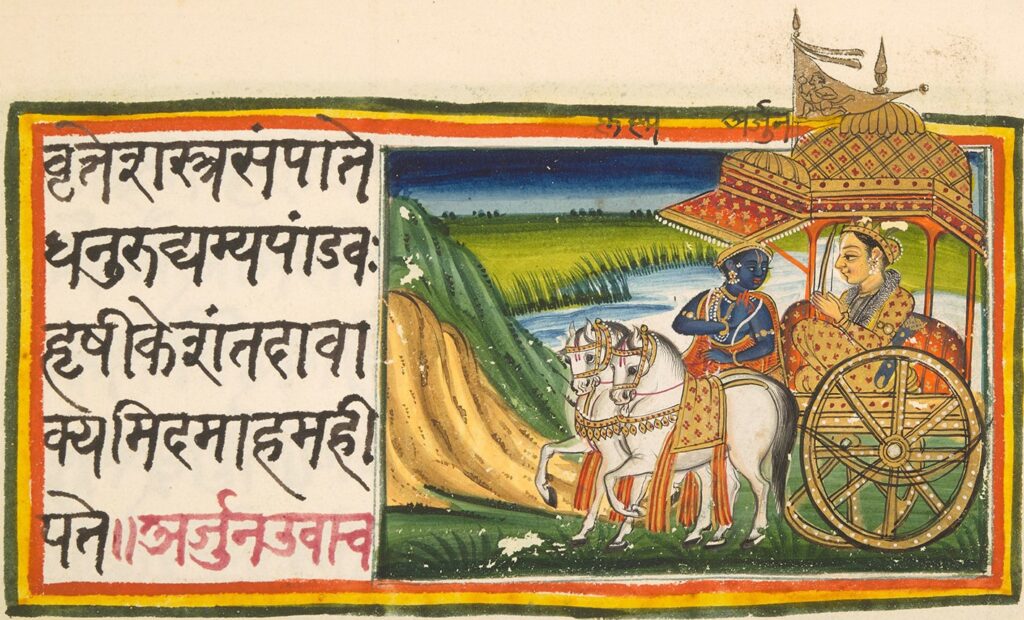Exploring the influence of the Bhagavad Gita on Iyengar Yoga.
In the introduction to her commentary on the Gita Laurie Patton writes …
‘Throughout the centuries, the Gita has been understood as containing three basic instructions for how to live according to these three paths: of action (karma marga), of knowledge (jnana marga) and of devotion (bhakti marga). Each has been extolled at various points as the ‘central meaning’ of the text, and each of them is a compelling form of life, containing resonances, not only in ancient India, but also today. It is this translator’s view that, true to its sophisticated nature, the Gita places all three in productive tension with each other, and asks asks its readers and listeners to decide for themselves which path is best.’
Patton Laurie, The Bhagavad Gita
The Bhagavad Gita is one of the key texts in Yoga and is dated between 500-200 BCE. Often referred to as the Gita, is a sacred text that forms a profound part of the ancient Indian epic, the Mahabharata. Composed in Sanskrit verse, it is revered as a spiritual and philosophical masterpiece, containing profound, timeless wisdom. The Gita is set against the backdrop of the Kurukshetra War, where the prince Arjuna faces a moral dilemma on the battlefield. As he grapples with doubts and ethical concerns about engaging in the war against his own kin, Krishna, his charioteer and divine guide, imparts insights, guidance, and philosophical discourse to Arjuna, laying out the path to righteousness, duty, and liberation.
The Bhagavad Gita addresses fundamental questions of human existence, morality, duty, and the nature of reality. It explores paths to spiritual fulfillment, emphasizing the importance of selfless action, devotion, and the pursuit of knowledge. Through dialogue and discourse, it delves into the nature of the self, the concept of dharma (duty/righteousness), and the eternal principles governing life and the universe.
‘The yoga I teach is purely astanga yoga, known as the eight-limbed yoga, expounded by Patanjali in his 196 terse sutra, each of which reflects profound experiential knowledge. These are supplemented with hatha yoga texts, the Bhagavad Gita and others. Patanjali’s Yoga Sutra have attracted considerable attention and there are many commentaries on them. Most commentators have seen the subject of yoga objectively or from an academic angle. On the other hand, I have responded to it subjectively. Through my uninterrupted practice and its refinement I have compared my experiences and feelings with the original text’.
Iyengar BKS, Astadala Yogamala Volume 2. With Yogic eyes
To understand Iyengar’s comment above we need to look at the Gita and the sutras. Rather than a chapter by chapter analysis T-Ph27 is structured around the main questions in the Gita. It does not aim to be an academic work but an introduction to the themes and topics covered in the text. The aim is to reflect upon the relevance and influence of the Bhagavad Gita in Iyengar Yoga. This subject includes audio recordings of Geeta Iyengar’s talks on the Gita along with recordings from Prashant Iyengar’s talks, the writings of BKS Iyengar along with book extracts from commentators as well as articles, videos and quotes.
It is advisable to not rush through our subjects consuming the content quickly: apply a reflective mode where you might read an article prior to or immediately after practice. Where quotes are used they are often accompanied by an extract of the text. Look up other quotes used (as they often have the source and page noted) and read a fuller portion of the text. You might consider covering one section of each part each week in which case each part can be completed each month. The whole subject may cover 1 year of study and reflection.
We recommend that you purchase a copy of the Bhagavad Gita along with a copy of the Yoga Sutras of Patanjali in order to read the slokas and sutra. Suggested:
- The Bhagavad Gita by Eknath Easwaran
- Light on Yoga Sutras of Patanjali by BKS Iyengar
The Gita is wonderful source of knowledge, inspiration & reflection and I hope you will enjoy it as much as I have in shaping the material.


